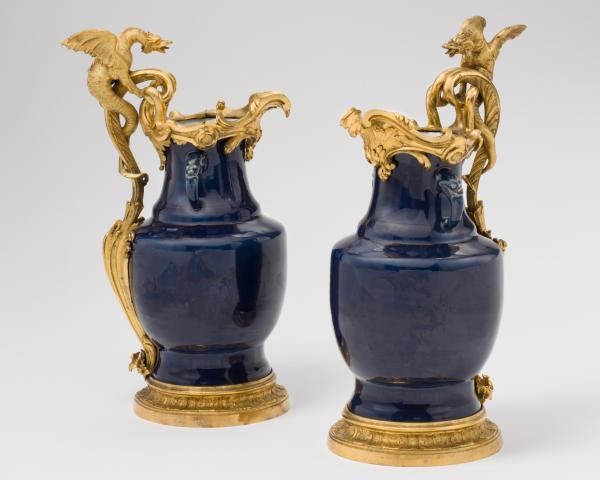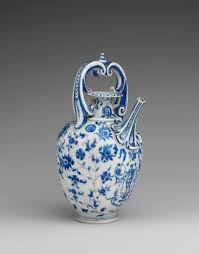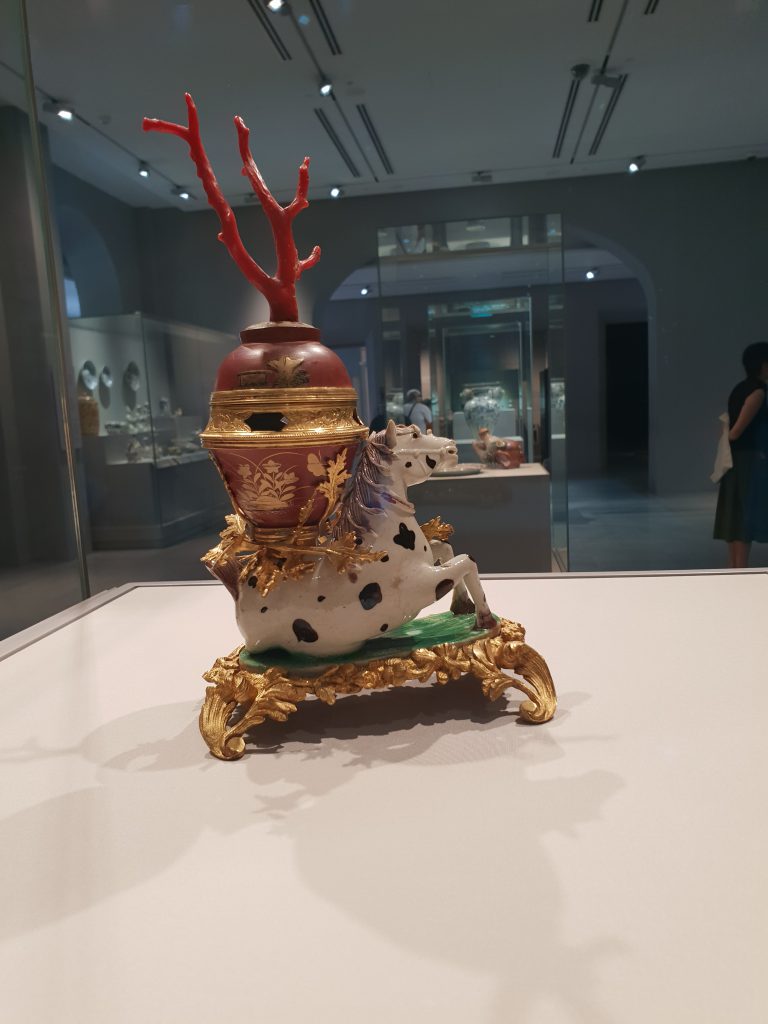Fig 1.
Visual Analysis
This pair of blue mounted jars is part of China’s popular blue and white porcelain series ever since the Tang Dynasty (AD 618-907). It is mounted with bronze material by the French around 1745-49 which was the start of the Chinoiserie period. Chinese blue and white porcelain have come a long way in terms of its techniques that allows the development of high fired temperature porcelains, types of decorations ranging from simple calligraphy to landscapes, animal motifs and other folklores or culture. Even though the Chinese blue and white porcelain declined during Qianlong’s grandfather reign, the Chinese still continued to produce these porcelains and managed to export to the European market, considering themselves very popular and highly demand up to this day.
By looking at this pair of blue mounted jars, one would attract most of their focus and attention to the dragon that is mounted on the jars. Because of the material used was bronze by the French, this dragon managed to have a striking bright colour of bronze attracting the viewers’ attention to the pair of jars. Furthermore, the French people’s way of making the dragon to appear emphasised in its three dimensional form allowing the dragon to stand out even more. Both dragons also have a pose that accentuates the curves of the jars very nicely. This is evident as shown for both dragons left and right are holding on a vine that is matching the outline of the jar and is curving inwards, giving the overall shape of the jar to look more balanced and evenly weighted.
Moreover, the image of the dragon stands out more than another image that is the hidden landscape on the jars. As a result, viewers would tend to look at the dragon first followed by the jar. They may not notice the landscape unless they were to look closely at the jars. To summarise, it is because of the bronze materials the French used that brings out a bright colour for the dragon and the ability to mount or gilded in this case, into a three dimensional figure, calling out attention to the viewers.
The overall colour of the jars are mainly a combination of deep blue hue and bronze which helps give the work a more elegant and sophisticated feeling towards the viewers. The deep blue is also in contrast with the striking bronze colour of the dragon, thus, hiding the landscapes that is painted by the Chinese during the Qianlong reign. If one could look closely, they could actually see hidden landscapes features such as mountains, trees, rivers, and so on.
Both jars appear to have an anthropomorphic human like feature including a head, neck, body and legs that is the base at the bottom made from the gilded bronze material. Because of the anthropomorphic figure, the lines do help complement the figure quite nicely making the jars more well-rounded and smooth. Moreover, the smooth and glazed texture also accentuates and complements the curves of both beautifully mounted jars giving it a more elegant and polished look.
Contextual Analysis
As mentioned in my visual analysis, both jars have a deep range of blue colour. This colour, blue is imported from Persia and was initially imported as cobalt oxide as cake form which was then grounded into powder. [1] The Chinese would then use these powder to produce their blue and white porcelains that was arguably started around the early 14th century in Jingdezhen. The porcelains were at first underglaze and low fire temperature. It was only until the Yuan Dynasty, where the advancement of pottery making starts to develop, the people in China, especially in Jingdezhen, made way for better and advanced technique that allows high fired temperature leading to larger size porcelains as shown in my image. [2]
Both jars were made during the Chinoiserie period which most likely started after the 13th century where Marco Polo described about Chinese blue and white porcelains in his notes to the West. However, these blue and white porcelains did not get the high exposure and demand until 200 years later, the Portugese Da Gamma discovered the sea route to India [3]allowing Europe to pave more trade routes and imports from East Asia. Furthermore, during the 15th century or Yongle period of the Ming Dynasty, China’s great navigator Zheng He decided to establish close political and trading relationships between China and Europe. The political friendships that both China and Europe have would then be influenced on the decorations that the French had decided to imitate on the Chinese porcelains.
The Chinese porcelain we see here is a dragon that has wings and posing at the top of the jar. This dragon is actually a mythical creature which the French tried to imitate and apply on the Chinese porcelains which they imported from China. There had been a series of cultural exchange between the two countries which led to a fascination of chinoiserie motifs inspired from Chinese folk art and culture. Scholars may point out that because of Zheng He “brought out porcelains to Europe an made them fully understand the Oriental Dragon China “and expanded cultural exchanges.”
As for the landscape, it is a coastal scenery that is painted in an impressionistic style that we are actually seeing, that is probably decorated to suit the European market. The designs on porcelains have actually developed to become more elaborated and stylised as they have evolved from calligraphy prints to images of animal motifs and landscapes to stylised and elaborated animal motif and landscapes. [4]It is the style that we are seeing that changes the appearance of motifs on the porcelains which helped China made way for a more prosperous trading economy. Because they are able to change their way of decorations to suite the European market, China managed to receive higher demands and an increased trading relationship with Europe.
Additionally, these beautifully decorated and mounted porcelains were meant for the Europeans as dining wares or collection items. [5] Surprisingly, as the demand for porcelain increased, more Europeans got engaged with Chinese art and made their own porcelain. The first attempt was made by architect Bernado Bountalenti and it was decorated with very early chinoiserie motifs. Like the image below, the porcelain is decorated in blue and white with chinoiserie motifs of flowers which the Europeans were mostly inspired by the Chinese during their cultural exchange to include features of landscapes in their porcelain works that is the floral patterns.
In conclusion, I can say that because of cultural exchanges between China and Europe, this trading relationship has an influence in the style on their porcelain works that is the motifs and the material implanted on the Chinese porcelain. Overall, this work gives viewers a sense of dynamism in terms of material and rich in culture that makes both jars look different aside from the usual blue and white Chinese porcelains we always see.
Fig 2.

Bibliography
[1] Sargent, William R. 2003 “Blue-and-white ceramic.” Grove Art Online. 3 Nov. 2018. http:////www.oxfordartonline.com/groveart/view/10.1093/gao/9781884446054.001.0001/oao-9781884446054-e-7000009347.
[2] Xue-Hui Li. “History and Craft of Chinese Export.” Ceramics Technical, no. 40 (May 2015): 82–87. http://ezlibproxy1.ntu.edu.sg/login?url=http://search.ebscohost.com/login.aspx?direct=true&db=a9h&AN=103115668&site=eds-live&scope=site.
[3] Xue-Hui Li. “History and Craft of Chinese Export.” Ceramics Technical, no. 40 (May 2015): 82–87. http://ezlibproxy1.ntu.edu.sg/login?url=http://search.ebscohost.com/login.aspx?direct=true&db=a9h&AN=103115668&site=eds-live&scope=site.
[4] Riccardi-Cubitt, Monique. 2003 “Chinoiserie.” Grove Art Online. 3 Nov. 2018. http:////www.oxfordartonline.com/groveart/view/10.1093/gao/9781884446054.001.0001/oao-9781884446054-e-7000017240.
[5] “Chinese Ceramics” China Online Museum. 3 Nov 2018. http://www.comuseum.com/ceramics/
Image Source
Fig. 1. Pair of mounted blue jars. Porcelain: China, around 1736–45. Gilded bronze mounts: France, around 1745–49. 2014-00709. Asian Civilization Museum. 3 Nov 2018. https://discover.acm.stqry.com/v/pair-of-mounted-blue-jars/s/ac1131f1-1747-45cd-8725-62f16b9b80d1
Fig. 2. Medici Porcelain Factory. Italian, Florence, ca. 1575–87. Soft-paste porcelain. 8 × 4 1/4 × 4 7/8 in. (20.3 × 10.8 × 12.4 cm). The Metropolitan Museum of Art, NY. 4 Nov 2018. https://www.metmuseum.org/art/collection/search/194432


